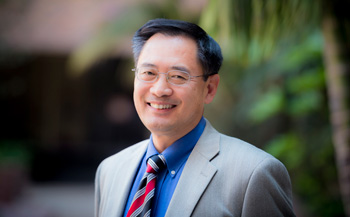May 10 2013
What does it mean to have 100G connectivity? Just how much data is a 100G connection capable of transmitting? The answer, it turns out, is quite a bit.
 Min Yao
Min Yao
A fully loaded 100G link should be able to:
- Transfer the data equivalent of 80 million file cabinets filled with text, daily
- Enable 1.8 million people to download an e-book simultaneously in just over two minutes
- Transmit 300,000 X-rays in one minute
- Send smartphone data at 50,000 times faster than current average speeds
For researchers at UC San Diego, this means that they will be able to share data-intensive research and learning projects with colleagues across the country and around the world. This type of ultra-high performance networking is expected to revolutionize science, medicine, media arts, smart manufacturing, scientific workflows and network research itself, as well as give participating campuses the opportunity to examine the cyberinfrastructure necessary to enable them to take full advantage of the coming bandwidth.
“100G networking is transformational,” said Greg Bell, director of the U.S. Department of Energy’s Energy Sciences Network, during a recent conference at UC San Diego on the future of research networks in California. “Faster data means faster discovery in fields as diverse as genomics, particle physics, climate and materials sciences.
While the 100G uplink connection will be available to UC San Diego this spring, the university’s office of Administrative Computing and Telecommunications (ACT) will distribute it to the campus research community within the next 18 months. ACT is working with the Corporation for Education Network Initiatives in California (CENIC) to add the 100G connection, which will be in addition to UC San Diego’s existing 40G Internet connectivity.
“Adding 100G connectivity will represent a major milestone towards our goal of deploying the most advanced computer network for UC San Diego’s network-based research, learning and innovation activities,” said Min Yao, assistant vice chancellor of ACT. “This enhanced network capacity will prepare us to meet the exponential growth expected in data-intensive research network traffic.”
Before UC San Diego can implement the connection, CENIC must first complete building out their 100G pipe to San Diego. The university is already connected to CENIC’s California Research and Education Network (CalREN), the advanced network that serves California’s K-20 research and education communities. But CENIC is upgrading their California backbone networks to 100G and, initially, only a few selected research universities will have 100G connectivity. UC San Diego is one of these few universities.
CalREN consists of nearly 3,000 miles of fiber-optic cable running throughout California to which institutions in all 58 of the state’s counties connect via leased lines or dark fiber—fiber optic cable that is not currently being used. In addition to UC San Diego, it links nearly 10,000 California K-12 sites, the 112 campuses of California’s Community Colleges, all 23 campuses of the California State University, the other nine University of California campuses, private universities including Caltech, Stanford and the University of Southern California, along with numerous off-campus sites and other institutions. In addition to linking these education and research communities with each other, CalREN also links them with colleagues throughout the nation and the world.
Upgrading the network at UC San Diego is also part of the university’s commitment as an Internet2 campus. Internet2 is an advanced networking consortium led by the research and education community, which comprises U.S. and international institutions who are leaders in the worlds of research, academia, industry and government. The Internet2 community is developing breakthrough network technologies that support new applications and spark innovation. Much more than faster Web browsing or email, the capabilities developed and deployed by the Internet2 community enable completely new applications such as digital libraries, virtual laboratories, distance-independent learning and telemedicine.